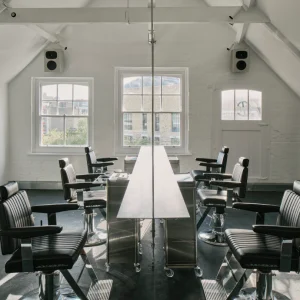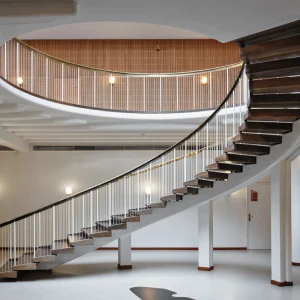
This is an exercise going forward in time – or back, in your case, since by the time you read this it should all be behind us. In another time-twisting curveball, what I’m writing about hasn’t happened yet. Usually one writes about an interviewee after one has interviewed them. Right now, as I write, I’m preparing for a live public interview – an ‘In Conversation’, some time ahead – with none other than Niels Diffrient,. Most of you will know him as the designer of the Humanscale chairs. The Freedom, the Liberty, and most recently the Diffrient World Chair – were heralded as game changers in task-chair design.
If they didn’t completely revolutionise the industry, it is certainly no fault of the venerable designer, now in his 80s, and almost certainly the fault of the market at large, which still, apparently, gives value to the complex, and in some cases unreasonably expensive, solutions of the company’s competitors.
Researching Diffrient, I keep coming across surprises. I’d always assumed he was a second generation, possibly first, incomer to the USA from northern Europe, as his name implies. And as his name implies, his family would almost certainly have settled in Wisconsin, Michigan, or even perhaps Minnesota, where many northern European immigrants set up home. Not a bit of it.
He was born in rural Mississippi, in a little farming community called Star, some 20 miles south east of Jackson. And he was born in 1928, when the world was very different, especially that part of it, and while still a child moved with his family to Detroit. The Southern location was surprising enough, but his early career tells us more of a story – if you’re good at reading between the lines – about the relationship between early 20th-century American and European industrial design. Whether Diffrient will be able or willing to articulate this when confronted with one of my carefully crafted questions remains a moot point until the question is actually asked, but it seems very clear that he had a good humanities-based education, and then quite rapidly came under the influence of Europeans.
In the late Forties he worked with Eero Saarinen, a Finnish American who had studied in Europe, producing some of the great Knoll classic chairs such as the Grasshopper and Womb, and as a Fulbright scholar went to Marco Zanuso’s studio in Milan in the early Fifties, working on a Borletti sewing machine that won the Compasso d’Oro. On his return to the USA he joined the studio of Henry Dreyfuss, where he stayed for 25 years.
A 2002 interview for TED.com starts with the charming phrase: ‘When I was five years old I fell in love with airplanes.’ That was 1933, remember, when the aircraft was barely 20 years old as a practicable mode of transport, when excitement, mystery and romance defined flying as an activity, and when having just recently conquered the air, the designers and manufacturers of flying machines must have been intoxicated with unrealised potential.
‘But this was real romance to me,’ Diffrient continued. ‘Everything about flying in those years was probably the most advanced technological thing going on at the time. So as a youngster, I tried to get close to this by drawing airplanes, constantly drawing airplanes. It’s the way I got a part of this romance. And of course, in a way, when I say romance I mean in part the aesthetics of that whole situation – I think the phrase is the holistic experience revolving around a product. The product was that airplane, but it built a romance… So that it was something that just got into your spirit. It did mine.’
He goes on to explain how he followed his dream into a course in aeronautical engineering, but soon discovered that to realise the romance of flight, drawing ‘appearance’ drawings was not enough. He had to study wing shapes, airflow, aerodynamics – and the drawings were no longer representational, but technical.
‘And when I was sitting in classes – in which no one asked me to draw an airplane – to my surprise, I had to learn mathematics and mechanics and all this sort of thing. I’d while away my time drawing airplanes in the class. One day a young man looked over my shoulder, and he said, "You draw very well. You should be in the art department." And I said, "Why?" And he said, "Well, for one thing, there are more girls there".
‘So my romance was temporarily shifted. And I went into art because they appreciated drawing. Studied painting; didn’t do very well at that. Went through design, some architecture. Eventually hired myself out as a designer. And for the following 25 years, living in Italy, living in America, I doled out a piece of this romance to anybody who’d pay for it – this sense, this aesthetic feeling, for the experience revolving around a designed object. And it exists.
‘After 25 years I felt as though I was running dry. And I quit. I wanted to get back where the romance was. I chose furniture. And I chose chairs specifically because I knew something about them. I’d designed a lot of chairs over the years for tractors and trucks and submarines -all kinds of things. But not office chairs. So I started doing that, and I found that there were ways to duplicate the same approach that I used on the airplane.
‘Only this time, instead of the product being shaped by the wind, it was shaped by the human body. So the discipline was – in the airplane you learn about how to deal with the air, for a chair you have to learn a lot about how to deal with the body, and what the body needs, wants, indicates it needs.
‘When I started the chair it was not a preconceived notion; I began with a lot of loose ideas that had something to do with what I knew happened with people who worked and used task seating, a great many of them sitting in front of a computer all day long. And I felt the one thing they didn’t need was a chair that interfered with their main reason for sitting there.
‘So I took the approach that the chair should do as much for them as humanly possible or as mechanistically possible so that they didn’t have to fuss with it. So my idea was that instead of sitting down and reaching for a lot of controls, you would sit on the chair, and it would automatically balance your weight against the force required to recline.’
Hence, Humanscale – which is also the title of three ‘human engineering’ reference books co-authored by Diffrient and two of his colleagues at Henry Dreyfuss, published from 1974 to 1981. And which has led him to be dubbed, perhaps a little bombastically, ‘the Grandaddy of Ergonomics’.
1980 was the year Diffrient went out on his own; he didn’t meet Bob King, then and now the CEO of Humanscale, until 1998. King was looking for a premium office chair that would somehow challenge Aeron, the Herman Miller design that at the time was carrying everything before it. The sweetness of the Freedom chair’s automatic and apparently sensitive ability to self-adjust caused a sensation at NeoCon in 2000; I remember it very well, because I was there.
It was one of those rare, beautiful design moments. You turn a corner or enter a room, and there in front of you is, well, if not a perfect solution, then a solution that shouts ‘THIS IS THE RIGHT WAY TO DO IT’ so loudly that it’s impossible to ignore.
As I said at the beginning, the only reason why we aren’t all sitting on such chairs now is much more to do with the psychology of markets than it is the merit of the design.
I still don’t really understand how task seating can be as full of romance as airplanes of the Thirties, but I’ll have to wait to ask Mr Diffrient about that. I can hardly wait.





